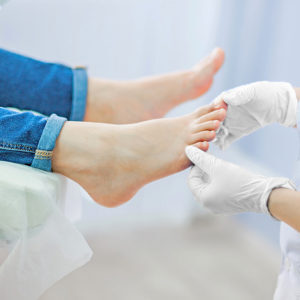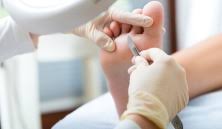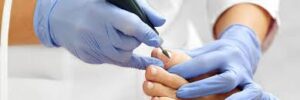General Footcare and Assessments
At Hurst Podiatry, we provide general footcare services for people of all ages at our clinics in Healesville, Croydon, Kilsyth and Mooroolbark.
If you’re experiencing pain, injuries, discomfort or any issues with your feet and/or lower limbs in Melbourne, book an appointment to see us now.
What is General Footcare?
When we talk about general footcare, we refer to the treatment of primary or more basic foot care concerns. For example, this could be the management and cutting of toenails, as well as corns and callused skin.
Our general footcare services are available to people of any age and are commonly used by those who unfortunately can no longer manage taking care of their feet. Most people can relate to the feeling that your feet don’t get any closer as you get older!


What is involved in a General Footcare appointment?
A general care appointment is effectively a medical grade pedicure at Hurst Podiatry. Our aim is to have your feet healthy and feeling good at the end of your appointment.
Often, your general foot care appointment will normally involve the following:
- An aseptic wipe down on your feet with an alcohol based product to eliminate any bugs on the areas we are about to work on
- We will begin with an inspection of the feet checking in between toes, testing pulses and making sure there are no issues since last we cared for you
- We will then cut and file your nails back using sterilised equipment and a podiatry “drill” which is essentially and electric file that can thin and shape nails
- Next we will carefully remove any dry and calloused skin using the file on our drill and a scalpel blade
- We will remove any corn or other lesions we will need taking care of
- We will apply a moisturiser to your feet by finishing with a short massage of the feet.




What is treated during a General Footcare appointment?
There are many conditions that may be addressed and treated during a general foot care appointment, the most common usually being nail trimming, corn removal and callous removal.
Podiatrists do vast levels of training to master the art of cutting nails precisely and have a great understanding of the best way to do this.
Podiatrists also are the best equipped health professionals when comes to the removal of corns and callouses they have extensive practise with scalpels to safely and accurately remove them to reduce pain and discomfort without causing any undue damage.
Why Choose Hurst Podiatry for General Foot Care?
At Hurst Podiatry we pride ourselves in our knowledge and expertise in the field of podiatry, including our understanding of how to take care of your feet to prevent future problems and discomfort.
We believe in understanding your unique situation and finding the best treatment option for you. Our general foot care services are available to ensure that everyone has access to better foot health.
We approach your foot and lower leg health holistically and like to ensure that we’re providing you with the best and most effective treatment option to suit you and your condition.
We’re also here to answer any questions you have because we want all of our clients, including those who need a little extra help with their feet and nails in Melbourne, to achieve the best results possible.
If you need help with your feet in the East Melbourne suburbs, schedule an appointment at Hurst Podiatry today.
Frequently Asked Questions
-
Why does general foot care matter?
Taking care of your feet when you’re young and/or able might make it hard to see why you might need to see a podiatrist for general foot care matters like cutting nails. Well, as we get older, it doesn’t get any easier to reach down to our feet and make sure that we do a good job of taking care of our feet.
Poor eyesight, lack of strength in your hands, the inability to bend an arthritic knee, hip or back, or even something as simple as thickening of the nails, can make looking after your feet a lot more difficult.
Taking care of your foot health is important because the consequences of not doing it or doing it poorly can have severe consequences. For example, a poor nail cutting technique can lead to ingrown toenails and infections; corns and callouses that are left untreated can lead to ulcers, infections, and in extreme cases, gangrene and amputations. Elderly people and those who suffer from conditions like diabetes are especially at risk of having issues caused by a lack of foot care.
Luckily, a podiatrist can step in and help take care of your feet today.
-
How often do I need to be seen?
This varies depending on conditions and the severity of the condition someone may have.
For most people who can’t care for their feet at all will usually need to come and see us every 6-10 weeks.
We can work with you to establish the best length of time between appointments and create a care schedule for you.
-
How can I manage thick, dry and/or rough skin on my feet?
The best approach to dry, thick and rough skin is to lightly abrade the skin using something like an emery board. However, it is important to be very careful not to take too much skin away. It is always best to take less skin more often than to take off too much in one go.
After a shower, when the skin is a bit softer, can be the best time to tackle this task. After you have abraded as much skin as you think you need to apply a good amount of moisturiser and rub this in.
Try not to immediately jump and walk around as you will end up moisturising your carpet instead of your feet.
-
I have a corn, what should I do?
Some people will try and remove corns themselves using scissors or a sharp blade.
This is obviously fraught with danger and is very easy to get wrong.
You run the risk of cutting too much and creating a wound or infection or you don’t cut enough and getting little to no relief.
We might be biased but we think the best bet is to let us help you remove the corn safely and carefully.
We can also have a chat to you about what can be done to slow the corn down from coming back or stop it altogether.
-
Can I try a corn pad for a corn?
Most corn pads have salicylic acid in them to help burn the core of the corn out.
The problem here is despite how these pads are often marketed, the acid can and will burn any skin it comes into contact with, including any healthy normal skin near the corn.
This can cause a chemical burn resulting in infection or an ulcer.
The acid can also be affected by water making it run onto other skin burning that skin too.
We recommend having the corn carefully removed by our team and while we’re at it we can chat about trying to prevent the corn from coming back.
-
How can I take care of my toenails better?
The best technique for cutting your toenails, is to cut them straight across with a good set on nail clippers.
Avoid where possible cutting down the edge and do not try and remove or alter your cuticles, they are there as a barrier from infection!
-
Why can’t I just get a pedicure?
You can just have a pedicure but the approach between the two professions is quite different.
Pedicurists typically focus on cosmetic result and can overlook some key medical concerns, whereas podiatrists have a more medical focus, your foot and nail health are the main priority of the appointment.
Some of the key differences between how each profession approach caring for feet include:
- A pedicurist doesn’t have medical training, whereas a podiatrist studies for a university degree for four years.
- Feet are washed in in a basin that is used by others, while at a podiatry clinic we use hospital grade disinfectant to prepare your feet
- Gloves are not always worn by the person performing the pedicure, while a podiatrist will use medical grade gloves and PPE.
- Instruments and tools used in a pedicure salon are reused and not necessarily sterilised between uses, whereas at a podiatry clinic, all equipment gets an ultrasonic cleaning and autoclave sterilisation.
- Hygiene and infection control are not governed by a medical body for pedicurists, whereas a podiatrist must maintain standards that are in line with the AHPRA medical governing body.
- Pedicurists are not often trained on the safest techniques to remove dry skin, while a podiatrist is trained to use scalpels and medical equipment for precise skin removal.
- Pedicurists will cut nails to suit the clients preferences which usual have an aesthetic basis, whereas a podiatrist will employ the correct nail cutting approach to ensure your toenail health is maintained.
- Cuticles are often removed or cut back during a pedicure which can increase risk of infection. A podiatrist will manage your cuticles conservatively to ensure your risk of infection is significantly reduced.
- Pedicurists are not trained to have medical awareness of foot health, so they could do work on your feet that may result in complications. A podiatrist is trained to know what to look for when it comes to keeping your feet healthy.
- Contact surfaces are rarely cleaned to a high standard between pedicures. At our clinic we will disinfect all contact surface areas between patients to avoid the risk of infection.
-
Do I need a referral to come to Hurst Podiatry?
No, a referral is not required to book in to see us here at Hurst Podiatry.
We’re available to patients of all ages, whether you’ve experienced an injury, you need help taking care of your feet, or you’re experiencing discomfort in your lower limbs, because everyone is welcome here at Hurst Podiatry.
We have 5 clinic locations in the Eastern suburbs of Melbourne, including in Healesville, Croydon, Kilsyth, and Mooroolbark.
Book today by calling us on (03) 5901 2216 or booking online here.
